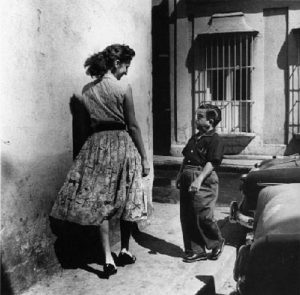
Leo Matiz took this picture in 1957, in Caracas, Venezuela. The photo was a “candid”, i.e. shot unbeknownst to the people portrayed, in the classic, Cartier-Bresson-like street-photography style, and acquired by the New York MoMA.
The name of the woman lasted unknown for 35 years, since only in 1992 she recognized herself by seeing the picture hanging on the wall of an exhibition in Milan.
According to a very questionable interpretation of ? both the UE data protection directive and the GDPR, this picture should never have been taken because of the lack of consent for publication (see the Italian Data Protection Authority “suggestions” for drone manning.)
“Magda and the Dwarf” is an example of how perverted is the meaning of the GDPR. Henry Cartier-Bresson, Gerry Winongrad, Vivian Meier, Daido Moryama, Vittorugo Contino, Caio Mario Garrubba, Calogero Cascio and the thousand of less known street-photographers around the world devoted their existence to freeze unstaged sketches of life.
Street-photography is an important contribution to the understanding of our society and its evolution over time and by no means should be restricted by a dull interpretation of the GDPR.
Thankfully, Leo Matiz and the other street-photographers of the past (giants, as well as unknown “camera-men”) had not to face these unacceptable limitations.
Unfortunately, we don’t share their luck.
So, if the Data “Protection” authorities will pursue such ignorant interpretation of the law, another picture like “Magda and the Dwarf” could never be taken again and, as time goes by, it will be impossible for us to remember how we were in another time or another place.
A perfect application on a global scale of the right to be forgotten or – better – of the duty of not being remembered.
